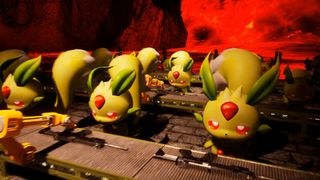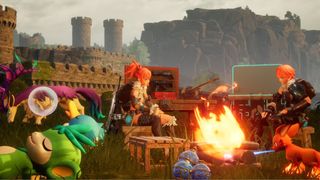
Much of the early hype around Palworld has hinged on its descriptor as 'Pokemon with guns'. It's an obvious selling point - Palworld's creature collecting mechanic (and apparent design ethos) draws immediate comparisons to Nintendo, and the juxtaposition of its colorful monsters with that violent subject matter makes for an easy elevator pitch. But that description falls flat in no time at all, a reductive marketing strapline that obscures what Palworld really is: a novel spin on factory management games.
Instructed by the tutorial, I spent the first few minutes of my time in Palworld fighting the local cats, sheep, and chickens, capturing them before tasking them with helping me with my crafting and resource-gathering. I got them to help me build a house and some beds for us all to sleep in, and made sure that their hunger meters were just as well-served as my own. I did fight off some wild pals with a bat, but I'd argue that's not really any worse than siccing a rat on a wild pigeon, as Pokemon fans have been doing for years.
It wasn't long before my progression was locked behind the requirement to build a berry plantation. I dutifully crafted a plot, and got to work sowing and watering the berry seeds I'd collected so far. It was an extremely drawn-out process - an entire agricultural cycle takes in excess of a minute, a long time for any crafting game to task you with setting down a single unit. It was so drawn-out, in fact, that I got bored and decided to wander off and do some proper exploring.
Catch 'em all

When you spawn into Palworld, you're met with a limited array of Pals, all of which are limited to relatively standard tasks, primarily crafting and basic resource gathering. Go a little further afield, however, and you're quickly introduced to Pals from a few different elemental types; in the course of my random exploration, I caught myself a few grass-types and a couple of water types, before eventually returning to base. I dropped my new arrivals into the active slots in my PC, transporting them into the world and letting them assign themselves work as I saw fit.
With my hunger meter ticking down after my excursion and my food supplies running low, I thought I'd better return to the drudgery of my berry field. Preemptively glancing down at my phone, I was ready to start the slow process of sowing some seeds before I realised that the field was already being watered, my elephant and penguin dowsing the soil. I'd not even planted the seeds yet, but here were two Pals already undertaking the next time-consuming step in the agricultural process.
Confused, I watched the field for a few minutes. As the berries grew, other Pals came to harvest them, transporting them into storage. With the field now fallow, two grass-types wandered up, and automatically started scattering seeds over the plot. Once their job was done, the water-types returned, and the cycle started over again. Thanks to my Pals, I was now in possession of an entirely self-sufficient berry-producing 'machine'.
I carried on watching my Pals, realising that while they weren't tending my crops, they were undertaking other work. Before my expedition, I'd built a logging area as part of the game's upgrade system, and I spotted a couple of the grass-types wandering over there in between harvests. It turned out that they possessed the 'Logging' ability, allowing them to cut down trees - an activity they'd automatically undertake if they didn't have a more pressing task. Elsewhere, I watched as my sheep-shaped Lamballs entered the ranch I'd built, where they'd graze and eventually drop wool. That wool would then be collected and stored by yet more Pals.
Sign up to the GamesRadar+ Newsletter
Weekly digests, tales from the communities you love, and more
The Pally drops

As I looked around, I realised I was seeing what Palworld really was. Behind its 'ultraviolent Pokemon' marketing, it was hiding a factory sim. As I discovered new technologies, I could capture different Pals to work my new machinery, eventually automating more and more bits of the system. The berry field is a microcosmic example of that loop at work - employ enough of the right Pals, and they'll take care of everything, generating an unending supply of food. Over time, as the products I'm making get more complicated, the conveyor system will follow suit, until my role becomes less factory grunt and more supply chain overseer.
That's exactly the kind of loop that an entire management game subgenre thrives on. Factory sims like Factorio and Satisfactory start with manual, menial labor and gradually automate greater and greater swathes of the game. I've seen similar ideas presented within the same kind of survival setting as Palworld - Scrap Mechanic, a cross between open-world survival and the machine-crafting of Besiege - pushes you further and further towards making your creations do the work that was originally your responsibility. With Palworld, those machines are replaced with critters, but the idea is the same, and it only took two hours before the inhumane facade that Palworld is hiding behind fell away to show me that.
There's no questioning the fact that Palworld probably isn't all that popular with the folks at PETA, but neither is Pokemon. And while Pocketpair might wear its black humor relatively openly, Palworld is far less obsessed with animal cruelty than I think it would like you to believe it is. Instead, it's a factory sim that swaps cogs for critters. The tools I'm using might need the occasional snack or bite to eat, but they fulfil the same overall purpose, and point towards the same end goal, as games that make their factory sim gameplay a far more deliberate selling point.

I'm GamesRadar's news editor, working with the team to deliver breaking news from across the industry. I started my journalistic career while getting my degree in English Literature at the University of Warwick, where I also worked as Games Editor on the student newspaper, The Boar. Since then, I've run the news sections at PCGamesN and Kotaku UK, and also regularly contributed to PC Gamer. As you might be able to tell, PC is my platform of choice, so you can regularly find me playing League of Legends or Steam's latest indie hit.
Most Popular



